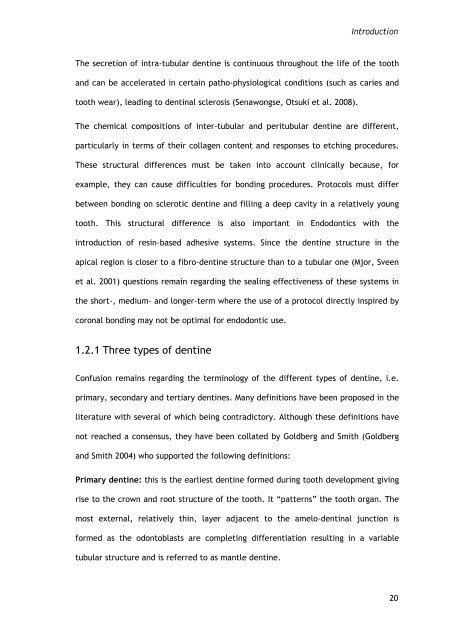Molecular characterisation of odontoblast during primary, secondary ...
Molecular characterisation of odontoblast during primary, secondary ...
Molecular characterisation of odontoblast during primary, secondary ...
Create successful ePaper yourself
Turn your PDF publications into a flip-book with our unique Google optimized e-Paper software.
Introduction<br />
The secretion <strong>of</strong> intra-tubular dentine is continuous throughout the life <strong>of</strong> the tooth<br />
and can be accelerated in certain patho-physiological conditions (such as caries and<br />
tooth wear), leading to dentinal sclerosis (Senawongse, Otsuki et al. 2008).<br />
The chemical compositions <strong>of</strong> inter-tubular and peritubular dentine are different,<br />
particularly in terms <strong>of</strong> their collagen content and responses to etching procedures.<br />
These structural differences must be taken into account clinically because, for<br />
example, they can cause difficulties for bonding procedures. Protocols must differ<br />
between bonding on sclerotic dentine and filling a deep cavity in a relatively young<br />
tooth. This structural difference is also important in Endodontics with the<br />
introduction <strong>of</strong> resin-based adhesive systems. Since the dentine structure in the<br />
apical region is closer to a fibro-dentine structure than to a tubular one (Mjor, Sveen<br />
et al. 2001) questions remain regarding the sealing effectiveness <strong>of</strong> these systems in<br />
the short-, medium- and longer-term where the use <strong>of</strong> a protocol directly inspired by<br />
coronal bonding may not be optimal for endodontic use.<br />
1.2.1 Three types <strong>of</strong> dentine<br />
Confusion remains regarding the terminology <strong>of</strong> the different types <strong>of</strong> dentine, i.e.<br />
<strong>primary</strong>, <strong>secondary</strong> and tertiary dentines. Many definitions have been proposed in the<br />
literature with several <strong>of</strong> which being contradictory. Although these definitions have<br />
not reached a consensus, they have been collated by Goldberg and Smith (Goldberg<br />
and Smith 2004) who supported the following definitions:<br />
Primary dentine: this is the earliest dentine formed <strong>during</strong> tooth development giving<br />
rise to the crown and root structure <strong>of</strong> the tooth. It “patterns” the tooth organ. The<br />
most external, relatively thin, layer adjacent to the amelo-dentinal junction is<br />
formed as the <strong>odontoblast</strong>s are completing differentiation resulting in a variable<br />
tubular structure and is referred to as mantle dentine.<br />
20
















